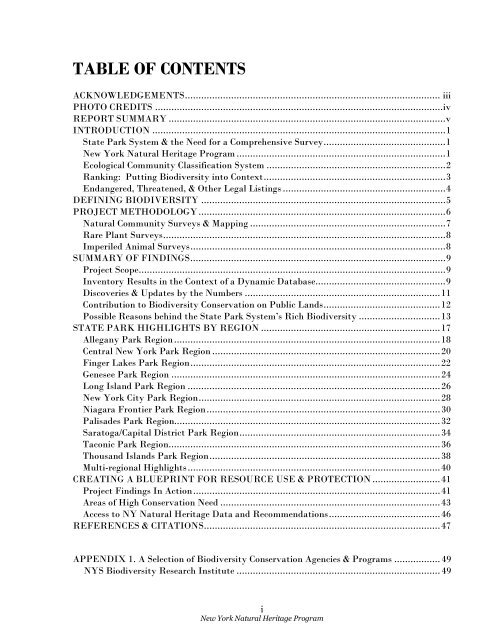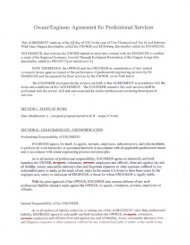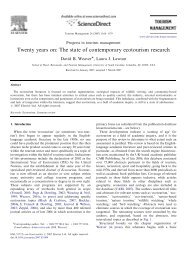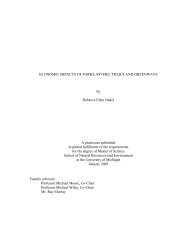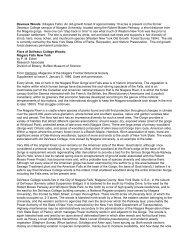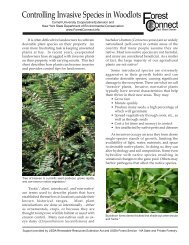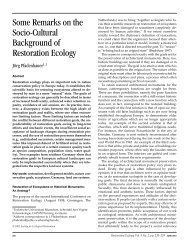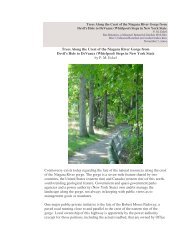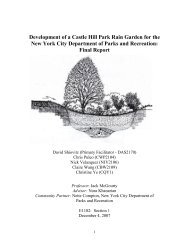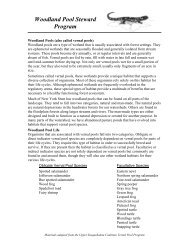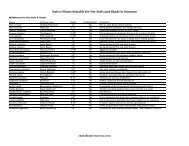NYS Parks Biodiversity Section 1 - Wild Ones Niagara Falls and ...
NYS Parks Biodiversity Section 1 - Wild Ones Niagara Falls and ...
NYS Parks Biodiversity Section 1 - Wild Ones Niagara Falls and ...
Create successful ePaper yourself
Turn your PDF publications into a flip-book with our unique Google optimized e-Paper software.
TABLE OF CONTENTS<br />
ACKNOWLEDGEMENTS.............................................................................................. iii<br />
PHOTO CREDITS ..........................................................................................................iv<br />
REPORT SUMMARY ......................................................................................................v<br />
INTRODUCTION ............................................................................................................1<br />
State Park System & the Need for a Comprehensive Survey.............................................1<br />
New York Natural Heritage Program .............................................................................1<br />
Ecological Community Classification System ..................................................................2<br />
Ranking: Putting <strong>Biodiversity</strong> into Context...................................................................3<br />
Endangered, Threatened, & Other Legal Listings ............................................................4<br />
DEFINING BIODIVERSITY ..........................................................................................5<br />
PROJECT METHODOLOGY...........................................................................................6<br />
Natural Community Surveys & Mapping ........................................................................7<br />
Rare Plant Surveys........................................................................................................8<br />
Imperiled Animal Surveys..............................................................................................8<br />
SUMMARY OF FINDINGS..............................................................................................9<br />
Project Scope.................................................................................................................9<br />
Inventory Results in the Context of a Dynamic Database................................................9<br />
Discoveries & Updates by the Numbers ........................................................................11<br />
Contribution to <strong>Biodiversity</strong> Conservation on Public L<strong>and</strong>s...........................................12<br />
Possible Reasons behind the State Park System’s Rich <strong>Biodiversity</strong> ..............................13<br />
STATE PARK HIGHLIGHTS BY REGION ..................................................................17<br />
Allegany Park Region..................................................................................................18<br />
Central New York Park Region ....................................................................................20<br />
Finger Lakes Park Region............................................................................................22<br />
Genesee Park Region ...................................................................................................24<br />
Long Isl<strong>and</strong> Park Region .............................................................................................26<br />
New York City Park Region.........................................................................................28<br />
<strong>Niagara</strong> Frontier Park Region......................................................................................30<br />
Palisades Park Region..................................................................................................32<br />
Saratoga/Capital District Park Region..........................................................................34<br />
Taconic Park Region....................................................................................................36<br />
Thous<strong>and</strong> Isl<strong>and</strong>s Park Region.....................................................................................38<br />
Multi-regional Highlights.............................................................................................40<br />
CREATING A BLUEPRINT FOR RESOURCE USE & PROTECTION .........................41<br />
Project Findings In Action...........................................................................................41<br />
Areas of High Conservation Need .................................................................................43<br />
Access to NY Natural Heritage Data <strong>and</strong> Recommendations.........................................46<br />
REFERENCES & CITATIONS.......................................................................................47<br />
APPENDIX 1. A Selection of <strong>Biodiversity</strong> Conservation Agencies & Programs ................. 49<br />
<strong>NYS</strong> <strong>Biodiversity</strong> Research Institute ........................................................................... 49<br />
i<br />
New York Natural Heritage Program
<strong>NYS</strong> Department of Environmental Conservation........................................................ 49<br />
<strong>NYS</strong> Department of State ........................................................................................... 49<br />
New York State Museum............................................................................................. 50<br />
Bird Conservation Area Program ................................................................................. 50<br />
Breeding Bird Atlas..................................................................................................... 50<br />
Ecoregional Planning by The Nature Conservancy ....................................................... 50<br />
Hudson River Estuary Program .................................................................................. 51<br />
Important Bird Areas Program.................................................................................... 51<br />
New York GAP Analysis Project ................................................................................. 51<br />
Northern Forest Initiative........................................................................................... 52<br />
APPENDIX 2. Summary of State <strong>Parks</strong> Assessed through this Project............................. 53<br />
APPENDIX 3. Rare Species & Significant Natural Communities Documented in the State<br />
Park System ................................................................................................................... 59<br />
Imperiled Animals....................................................................................................... 59<br />
Rare Plants................................................................................................................. 61<br />
Natural Communities .................................................................................................. 66<br />
APPENDIX 4. Rare Species & Significant Natural Communities, by State Park Region.... 69<br />
APPENDIX 5. Bibliography of State Park Reports ......................................................... 95<br />
LIST OF TABLES<br />
Table 1. Global, State, <strong>and</strong> Occurrence Quality Ranks ....................................................... 3<br />
Table 2. Rare & Imperiled Species on State Park Facilities Relative to Other Public L<strong>and</strong>s13<br />
Table 3. Globally Rare Species & Natural Communities on State Park Facilities Relative to<br />
Other Public L<strong>and</strong>s.................................................................................................... 13<br />
LIST OF FIGURES<br />
Figure 1. Full Natural Community Map of Chittenango <strong>Falls</strong> State Park.......................... 10<br />
Figure 2. Office of <strong>Parks</strong>, Recreation <strong>and</strong> Historic Preservation Regions ........................... 16<br />
Figure 3. Distribution of Rare Species <strong>and</strong> Significant Natural Community Types within<br />
State Park Regions .................................................................................................... 17<br />
Figure 4. Chimney Bluffs State Park has New York’s best example of a Great Lakes<br />
shoreline bluff............................................................................................................ 40<br />
Figure 5. NY Natural Heritage biologists, such as zoologist Jesse Jaycox, are already<br />
working with state park managers to resolve potential conflicts between hikers <strong>and</strong><br />
rattlesnakes, including this 42” yellow-phase specimen in the Hudson Valley ............... 42<br />
ii<br />
New York Natural Heritage Program
ACKNOWLEDGEMENTS<br />
This report is a summary of six years of biodiversity inventories within the New York State<br />
Park System. These inventories would not have been possible without programs put into place<br />
by the state. The <strong>NYS</strong> <strong>Biodiversity</strong> Research Institute played a critical role in advancing these<br />
studies through funding from the Environmental Protection Fund. The State Office of <strong>Parks</strong>,<br />
Recreation <strong>and</strong> Historic Preservation (OPRHP) <strong>and</strong> the Department of Environmental<br />
Conservation (DEC) provided substantial support for this project.<br />
Cliff Siegfried of the New York State Museum, Andy Beers of The Nature Conservancy, <strong>and</strong><br />
David Miller of Audubon New York are also acknowledged for their interest in <strong>and</strong> contribution to<br />
the identification <strong>and</strong> protection of the biodiversity resources in the New York State Park System.<br />
This project was possible because of the vision <strong>and</strong> leadership of Tom Lyons, Director of<br />
Environmental Management in OPRHP. His efforts have encouraged research, integrated the best<br />
available science into l<strong>and</strong>-use decisions, <strong>and</strong> welcomed the involvement of key partners. Tom’s<br />
support <strong>and</strong> enthusiasm for biodiversity information was evident from day one; he was applying our<br />
work to management issues <strong>and</strong> research questions in state parks often before we could finish<br />
processing the information <strong>and</strong> write the report. For the duration of the project, Tom provided vital<br />
feedback on our work from regional <strong>and</strong> park staff that helped focus recommendations <strong>and</strong> followup<br />
work in several state parks. Nancy Pierson in OPRHP was also key to this project’s success; she<br />
worked closely with Tom in developing a vision for environmental management in state parks <strong>and</strong><br />
continues to be a key point of contact at OPRHP. Nancy was always available to answer questions,<br />
facilitate contact with state park staff, <strong>and</strong> provide logistical information needed to get the job done.<br />
Special appreciation is further extended to the staff of OPRHP, specifically regional <strong>and</strong> park staff,<br />
for their cooperation <strong>and</strong> assistance in this biodiversity project.<br />
This project was conducted between 1998 <strong>and</strong> 2004 by the New York Natural Heritage<br />
Program under contract with OPRHP. It was initiated by Dr. Kathryn Schneider, former Director<br />
of NY Natural Heritage, <strong>and</strong> we are grateful for the ambitious vision she brought to the initiation<br />
of this project. DJ Evans coordinated this complex project <strong>and</strong> its many participants, in addition<br />
to conducting many of the natural community field surveys, overseeing contracts, <strong>and</strong> preparing<br />
many of the state park reports. Paul Novak <strong>and</strong> Troy Weldy worked on the project for six years<br />
<strong>and</strong> conducted the lion’s share of species surveys, oversaw the work of several contractors, <strong>and</strong><br />
spent countless hours reporting on their findings. Heidi Krahling single-h<strong>and</strong>edly created all of<br />
the report maps <strong>and</strong> oversaw the details of information management for five years on the project.<br />
Rachel Novak ensured quality control of all data being entered into the NY Natural Heritage<br />
database <strong>and</strong> worked with staff in maintaining high data st<strong>and</strong>ards for the duration of the project.<br />
Other NY Natural Heritage staff who contributed significantly to field surveys <strong>and</strong> worked<br />
tirelessly on report preparation included Adele Olivero, Aissa Feldmann, Shane Gebauer, <strong>and</strong><br />
Jesse Jaycox. Numerous other NY Natural Heritage staff assisted with field inventories, data<br />
management, map creation, <strong>and</strong> report production, including: Debbie Albert, Nick Conrad, Nancy<br />
Davis-Ricci, Greg Edinger, Andy Finton, Charlene Houle, Dr. Tim Howard, Dr. David Hunt, Betty<br />
Ketcham, Dana MacDonald, Teresa Mackey, Kirstin Seleen, Hollie Shaw, <strong>and</strong> Steve Young. Fiona<br />
Lewis provided invaluable assistance with contract writing <strong>and</strong> interpretation, <strong>and</strong> in working<br />
with state parks staff on contract issues. Contract biologists that participated in the project were:<br />
Timothy Baird, Spider Barbour, Michael Batcher, Steve Biasetti, Dr. Orl<strong>and</strong> “Skip” Blanchard, Jr.,<br />
Dr. Richard Bothner, Dr. William Cook, Michael Corey, Craig Denesha, Daniel deRoos, Robert<br />
Dirig, Ted Elliman, Jack Focht (OPRHP), Dr. Wayne Gall (Buffalo Society of Natural Sciences), Ed<br />
McGowan, Kathy Michell, Rob Michell, Dr. Gerry Moore (Brooklyn Botanic Garden), Tim<br />
Repicky, Fred Sibley, R<strong>and</strong>y Stechert, Valerie Giles Vallely, <strong>and</strong> David Werier. The project also<br />
benefited greatly from the volunteer assistance of: Jim Ash, Doug Bassett (OPRHP), Mike Clark<br />
(DEC), Louise Clemency (USFWS), Tom Cobb (OPRHP), Mike Cooper (DEC), Scott Crocoll<br />
(DEC), Jim Eckler (DEC), Nancy Edblom, Gil Hanse, Nancy Heaslip (DEC), Carl Herzog (DEC), Al<br />
iii<br />
New York Natural Heritage Program
Hicks (DEC), Bruce Horwith, Joe Jansen, Anne Johnson, Dr. Glenn Johnson, Steve Joule (DEC),<br />
George Kiesel, Dr. Eric Lamont, Gary Lawton (OPRHP), Richard Lynch, Annie McIntyre<br />
(OPRHP), Ray Mattarazzo, Dr. Ed McGowan, Dr. Richard Mitchell, Robyn Niver (USFWS), Brian<br />
Sitani, John Sullivan, Tom Torma (OPRHP), Joanna Tuk, <strong>and</strong> Bob Zaremba.<br />
PHOTO CREDITS<br />
Cover. Short-eared owl by A.J. H<strong>and</strong><br />
Page vii. Watkins Glen State Park by Troy Weldy, NY Natural Heritage Program<br />
Page viii. Pitcher plant by Troy Weldy, NY Natural Heritage Program<br />
Page 2. Bald eagle by U.S. Fish & <strong>Wild</strong>life Service<br />
Page 3. Sky-blue aster by Troy Weldy, NY Natural Heritage Program<br />
Page 4. Comet darner by Blair Nikula<br />
Page 5. Eastern spiny softshell turtle by U.S. Fish & <strong>Wild</strong>life Service<br />
Page 6. Dwarf pine ridge by The Nature Conservancy<br />
Page 7. White camas by Troy Weldy, NY Natural Heritage Program<br />
Page 8. Indiana bat by Merlin Tuttle, Bat Conservation International<br />
Page 9. Peregrine falcon by Kent Keller<br />
Page 12. (top) Basil mountain-mint by Troy Weldy, NY Natural Heritage Program<br />
(bottom) Torrey’s mountain-mint by Troy Weldy, NY Natural Heritage Program<br />
Page 15. Cobblestone tiger beetle by Barry Hart, Alabama Natural Heritage Program<br />
Page 19. Allegany State Park old growth forest by Adele Olivero, NY Natural Heritage Program<br />
Page 21. American hart’s-tongue fern by Stephen Young, NY Natural Heritage Program<br />
Page 23. Taughannock <strong>Falls</strong> State Park shale cliff & talus community by Adele Olivero, NY<br />
Natural Heritage Program<br />
Page 25. (top) Letchworth State Park by Yuan Sun<br />
(middle) Goldenseal by Stephen Young, NY Natural Heritage Program<br />
(bottom) Butterwort by Erick Dronnet<br />
Page 27. (top) Seabeach amaranth by Stephen Young, NY Natural Heritage Program<br />
(bottom) Children on beach by Stephen Young, NY Natural Heritage Program<br />
Page 29. Post oak-blackjack oak barrens by DJ Evans, NY Natural Heritage Program<br />
Page 31. (top) <strong>Niagara</strong> Gorge by Troy Weldy, NY Natural Heritage Program<br />
(bottom) Slender blazingstar by Al Schotz<br />
Page 33. Timber rattlesnake by R<strong>and</strong>y Stechert<br />
Page 35. (top) Thacher State Park waterfall by Troy Weldy, NY Natural Heritage Program<br />
(bottom) Eastern small-footed bat by Alan Hicks, <strong>NYS</strong> Dept. of Env. Conservation<br />
Page 37. (top) Taconic State Park by Troy Weldy, NY Natural Heritage Program<br />
(bottom) Violet wood-sorrel by Linda Lee, University of South Carolina Herbarium<br />
Page 39. Short-eared owl by A.J. H<strong>and</strong><br />
Page 40. Chimney Bluffs State Park by Adele Olivero<br />
Page 41. Giant pinedrop by Stephen Young, NY Natural Heritage Program<br />
Page 42. Timber rattlesnake by EdMcGowan<br />
Page 44. Tiger salam<strong>and</strong>er by Didier Ludovic, Universite de Rouen<br />
Page 45. Northern cricket frog by Jack Hecht<br />
Page 46. Gray petaltail by Blair Nikula<br />
iv<br />
New York Natural Heritage Program
REPORT SUMMARY<br />
In addition to providing some of New York’s finest recreational opportunities, the state park<br />
system harbors some of the state’s most imperiled <strong>and</strong> significant biological treasures. In 1996,<br />
the Office of <strong>Parks</strong>, Recreation <strong>and</strong> Historic Preservation (OPRHP) partnered with the NY<br />
Natural Heritage Program <strong>and</strong> the <strong>NYS</strong> <strong>Biodiversity</strong> Research Institute to develop a better<br />
underst<strong>and</strong>ing of what <strong>and</strong> where these biological treasures were <strong>and</strong>, in turn, to help OPRHP<br />
managers make more informed l<strong>and</strong>-use decisions.<br />
Rare species <strong>and</strong> significant natural communities are not just found in isolated areas rarely<br />
visited by people. Many live close to, or in the midst of, popular recreation areas, such as piping<br />
plovers on Orient Beach <strong>and</strong> gray petaltail dragonflies at Watkins Glen. Protecting these species<br />
can be accomplished in concert with providing outst<strong>and</strong>ing recreational opportunities. Through<br />
conservation <strong>and</strong> outreach efforts, visitors can learn about the wonderful <strong>and</strong> varied forms of life<br />
within New York’s borders.<br />
The primary goal for this project was to document the rare species <strong>and</strong> significant natural<br />
communities that occur within New York’s system of state parks <strong>and</strong> historic sites. This<br />
information is important because state park managers must balance a range of objectives when<br />
making l<strong>and</strong>-use decisions. Information obtained from the state park system also contributes to<br />
biodiversity knowledge which can be used to address biodiversity issues across the state. Another<br />
goal of the project was to map all of the natural communities for many state parks in an effort to<br />
determine what types of communities were there, the conditions of these communities, <strong>and</strong> how<br />
they might be affected by management activities <strong>and</strong> other factors such as invasive species.<br />
Nearly 75% of the state parks surveyed support at least one rare species<br />
population or significant natural community occurrence.<br />
All of these places are important for the protection<br />
of New York’s biodiversity.<br />
In all aspects of this project, NY Natural Heritage used a prioritized approach to data<br />
collection, focusing first on those species <strong>and</strong> communities of global significance <strong>and</strong> later on<br />
those of regional <strong>and</strong> state importance. State parks were selected for survey under the direction<br />
of OPRHP. Each park received one of three levels of survey effort:<br />
− In-Depth: Full natural community mapping <strong>and</strong> rare species population surveys were<br />
conducted in 105 state park facilities totaling 274,840 acres. Most of these state facilities<br />
had a significant proportion of natural area within their boundaries. Rare species <strong>and</strong>/or<br />
significant natural communities were documented in 91 of these properties.<br />
− Targeted: We undertook focused surveys for rare species <strong>and</strong> significant natural<br />
communities in 47 state parks <strong>and</strong> sites with a combined total acreage of 18,555 acres.<br />
Rare species <strong>and</strong>/or significant natural communities were documented in 36 of these<br />
properties.<br />
−<br />
Reconnaissance: Cursory surveys were conducted in 31 facilities totaling 4,160 acres.<br />
We found rare species <strong>and</strong>/or significant natural communities in eight of these locations.<br />
For each site with rare species <strong>and</strong>/or significant natural community occurrences, we<br />
developed a report which included: (a) a map showing the location of the species or natural<br />
community, (b) a fact sheet about each of the rare species <strong>and</strong> natural communities found, <strong>and</strong><br />
(c) management considerations to inform l<strong>and</strong> managers as they balance different l<strong>and</strong>-use<br />
objectives for the property.<br />
The findings from this project were dramatic:<br />
v<br />
New York Natural Heritage Program
! NY Natural Heritage has records of 924 existing occurrences of rare plants, imperiled<br />
animals, <strong>and</strong> significant natural communities that are completely or partially within 132<br />
state parks <strong>and</strong> sites. Of these, 487 were first documented during this project:<br />
− 213 significant natural community occurrences;<br />
− 131 imperiled animal populations; <strong>and</strong><br />
− 143 rare plant populations.<br />
! We updated the information on 403 rare species <strong>and</strong> natural community occurrences that<br />
had already been documented in the NY Natural Heritage database:<br />
− 65 significant natural community occurrences;<br />
− 110 imperiled animal populations; <strong>and</strong><br />
− 228 rare plant populations.<br />
! The 278 natural community occurrences found in state park facilities cover a total area of<br />
121,761 acres within state park boundaries.<br />
! The state park system has at least one outst<strong>and</strong>ing example of 90 of the 167 different natural<br />
community types that are currently tracked by NY Natural Heritage. State parks, therefore,<br />
include at least one significant, representative example of more than 50% of New York’s<br />
natural community types.<br />
! At least one existing occurrence of 91 different imperiled animals were documented within<br />
the state park system.<br />
! At least one existing occurrence of 178 different rare plant species (including five mosses)<br />
were found in the state park system.<br />
! The state park system is critical to the long-term protection of numerous rare species <strong>and</strong><br />
community types in New York <strong>and</strong>, in many cases, throughout the Northeast. Moreover,<br />
New York state parks are important to preserving our nation’s biological diversity.<br />
− State parks are home to 504 separate populations of plants <strong>and</strong> animals that are listed as<br />
state endangered or threatened.<br />
− State parks support the only known occurrences on public l<strong>and</strong>s of 104 rare species <strong>and</strong><br />
natural community types.<br />
− State parks include 191 occurrences of globally rare species <strong>and</strong> natural community types.<br />
In addition to detailing rare species <strong>and</strong> significant natural communities within the state<br />
park system, this project generated more than 550 management recommendations. OPRHP is<br />
actively using this broad suite of information to design <strong>and</strong> implement environmentally<br />
sensitive projects, prepare education programs, support research, <strong>and</strong> develop habitat<br />
protection plans. Having the information available early has also streamlined planning <strong>and</strong><br />
environmental review processes.<br />
OPRHP is also using the information from this project to support facility management. For<br />
example, NY Natural Heritage zoologists conducted follow-up field surveys with state parks staff<br />
to help them design alternative trail routes that would reduce potential interactions between<br />
hikers <strong>and</strong> timber rattlesnakes <strong>and</strong> minimize unintentional trampling of rare plant populations<br />
in Hudson Highl<strong>and</strong>s, Sterling Forest ® , <strong>and</strong> Minnewaska State <strong>Parks</strong>.<br />
The state park system harbors more than 900 occurrences<br />
of 359 different rare species <strong>and</strong> natural community types.<br />
vi<br />
New York Natural Heritage Program
Watkins Glen State Park in the Finger Lakes Region supports the state-special concern gray petaltail dragonfly, the<br />
federally threatened Leedy’s roseroot wildflower, <strong>and</strong> four significant natural community occurrences.<br />
vii<br />
New York Natural Heritage Program
Some plants have clever mechanisms for surviving in low-nutrient conditions. Pitcher plants, for example, use<br />
their vase-shaped leaves to capture insects. These plants grow throughout the state park system, including Lake<br />
Superior <strong>and</strong> Sterling Forest® State <strong>Parks</strong>.<br />
viii<br />
New York Natural Heritage Program
INTRODUCTION<br />
STATE PARK SYSTEM & THE NEED FOR A COMPREHENSIVE SURVEY<br />
In addition to providing some of New York’s finest recreational opportunities, the state park<br />
system harbors some of the state’s most imperiled <strong>and</strong> significant biological treasures. In 1998,<br />
the Office of <strong>Parks</strong>, Recreation <strong>and</strong> Historic Preservation (OPRHP) partnered with the NY<br />
Natural Heritage Program <strong>and</strong> the <strong>NYS</strong> <strong>Biodiversity</strong> Research Institute to develop a better<br />
underst<strong>and</strong>ing of what <strong>and</strong> where these biological treasures were <strong>and</strong>, in turn, to help OPRHP<br />
managers make more informed l<strong>and</strong>-use decisions.<br />
Rare species <strong>and</strong> significant ecosystems are not always found in isolated areas rarely visited<br />
by people. Many live close to, or in the midst of, popular recreation areas, such as piping plovers<br />
on Orient Beach <strong>and</strong> gray petaltail dragonflies at Watkins Glen. Protecting these species can be<br />
accomplished in concert with providing outst<strong>and</strong>ing recreational opportunities. Through<br />
conservation <strong>and</strong> outreach efforts, visitors can learn about the wonderful <strong>and</strong> varied forms of life<br />
within New York’s borders.<br />
The primary goal of this project was to identify <strong>and</strong> map the locations of imperiled animals,<br />
rare plants, <strong>and</strong> significant natural communities across the 325,000-acre state park <strong>and</strong> historic<br />
site system. This information is important because state park managers must balance a range of<br />
objectives when making l<strong>and</strong>-use decisions. This project was made possible by the<br />
Environmental Protection Fund through the <strong>NYS</strong> <strong>Biodiversity</strong> Research Institute. The <strong>NYS</strong><br />
<strong>Biodiversity</strong> Research Institute has improved our underst<strong>and</strong>ing of New York’s distinctive<br />
biodiversity by funding a vast array of projects.<br />
This project was the first effort ever to gather comprehensive information of the state park<br />
system’s biodiversity, particularly its rare <strong>and</strong> imperiled species <strong>and</strong> significant natural<br />
communities. It built, however, upon the local <strong>and</strong> regional work of countless biologists, l<strong>and</strong><br />
managers, <strong>and</strong> others who have been exploring New York’s natural diversity for more than a<br />
century. NY Natural Heritage was able to update many of the records made by these naturalists<br />
through the years. We also made many discoveries, including populations of animals previously<br />
thought extirpated from the state, <strong>and</strong> new locations of rare wildflowers found in few other<br />
places on earth.<br />
NEW YORK NATURAL HERITAGE PROGRAM<br />
NY Natural Heritage was established in 1985 <strong>and</strong> is a program within the <strong>NYS</strong> Department<br />
of Environmental Conservation’s (DEC) Division of Fish, <strong>Wild</strong>life, & Marine Resources. The<br />
program is staffed by more than 20 scientists <strong>and</strong> specialists with expertise in ecology, zoology,<br />
botany, information management, <strong>and</strong> geographic information systems.<br />
NY Natural Heritage maintains New York’s most comprehensive database on the status <strong>and</strong><br />
location of rare species <strong>and</strong> natural communities. We presently monitor 167 natural community<br />
types, 745 rare plant species, <strong>and</strong> 433 imperiled animal species across New York, keeping track<br />
of more than 10,900 locations where these species <strong>and</strong> communities have been found. The<br />
database also includes detailed information on the relative rareness of each species <strong>and</strong><br />
community, the quality of their occurrences, <strong>and</strong> descriptions of sites. The information is used<br />
by public agencies, the environmental conservation community, developers, <strong>and</strong> others to aid in<br />
l<strong>and</strong>-use decisions. Our data are essential for prioritizing those species <strong>and</strong> communities in<br />
need of protection <strong>and</strong> for guiding l<strong>and</strong>-use <strong>and</strong> l<strong>and</strong>-management decisions where these<br />
species <strong>and</strong> communities exist.<br />
1<br />
New York Natural Heritage Program
<strong>Biodiversity</strong> Highlight<br />
Bald Eagle Nests<br />
Can Be 6’ Across<br />
& 8’ Deep<br />
Bald eagles are great recyclers,<br />
reusing the same nest over <strong>and</strong><br />
over again. Each year they add a<br />
bit more until their nests are<br />
many feet deep <strong>and</strong> weigh<br />
hundreds of pounds.<br />
Bald eagles prefer to nest atop<br />
large white pines growing on the<br />
shores of lakes <strong>and</strong> large rivers.<br />
Logging <strong>and</strong> development<br />
destroyed many of these trees<br />
beginning in the 1800s, which<br />
began the eagle’s decline in New<br />
York. The few eagles that<br />
persisted into the mid-1900s<br />
could not reproduce successfully<br />
because of the egg-thinning<br />
effects of DDT <strong>and</strong> other<br />
chemicals, <strong>and</strong> by the 1960s only<br />
one pair was left in the state.<br />
In the 1970s <strong>and</strong> 1980s, state<br />
<strong>and</strong> federal government biologists<br />
began restoring bald eagles to<br />
New York, mostly from Alaskan<br />
stock. Today, more than 80<br />
breeding pairs <strong>and</strong> numerous<br />
wintering eagles soar in New<br />
York, many associated with state<br />
parks.<br />
Bald eagles have 6-7’ wingspans.<br />
NY Natural Heritage is an active participant in NatureServe<br />
– the international network of biodiversity data centers. There<br />
are currently Natural Heritage Programs in all 50 states <strong>and</strong><br />
several interstate regions. There are also 21 Conservation Data<br />
Centers, the international equivalent of Natural Heritage<br />
Programs, in Canada, Latin America, <strong>and</strong> the Caribbean. These<br />
programs work with NatureServe to develop biodiversity data,<br />
maintain compatible st<strong>and</strong>ards for data management, <strong>and</strong><br />
provide information about rare species <strong>and</strong> natural communities<br />
that is consistent across many geographic scales – from ¼-acre<br />
wetl<strong>and</strong> sites to the North American continent.<br />
NY Natural Heritage’s collaboration with NatureServe <strong>and</strong><br />
other states helps us put our information into a broader context.<br />
With NatureServe, we track the rarity of species <strong>and</strong> natural<br />
communities at global <strong>and</strong> state scales. This allows us to<br />
distinguish the conservation priority for an orchid with just four<br />
populations in the world from another orchid with four<br />
populations in New York but many populations elsewhere. We<br />
can also pool our data to look across state <strong>and</strong> international<br />
lines. For example, New York data on rare species <strong>and</strong> natural<br />
communities along Lake Ontario have been combined with<br />
similar data from Canada to facilitate analyses of potential<br />
consequences of lake-level changes.<br />
ECOLOGICAL COMMUNITY CLASSIFICATION SYSTEM<br />
In 1990, NY Natural Heritage published Ecological<br />
Communities of New York State, an all inclusive classification of<br />
natural <strong>and</strong> human-influenced communities (Reschke 1990).<br />
From 40,000-acre beech-maple mesic forests to 40-acre maritime<br />
beech forests, salt marshes to alpine meadows, our classification<br />
quickly became the primary source for natural community<br />
classification in New York <strong>and</strong> a fundamental reference for natural<br />
community classifications in the northeastern United States <strong>and</strong><br />
southeastern Canada. This classification, which has been<br />
continually updated as we gather new field data (Edinger et al.<br />
2002), has also been incorporated into, <strong>and</strong> in turn has helped<br />
define, the International Vegetation Classification that is being<br />
developed <strong>and</strong> refined by NatureServe, The Nature Conservancy,<br />
<strong>and</strong> Natural Heritage Programs throughout the Western<br />
Hemisphere (including New York) (NatureServe 2003, Grossman<br />
et al. 1998, Sneddon et al. 1998).<br />
The Federal Geographic Data Committee has established the<br />
International Vegetation Classification as the st<strong>and</strong>ard<br />
vegetation classification system for use by Federal government<br />
agencies <strong>and</strong> their cooperators (Federal Geographic Data<br />
Committee 1997). Further, the International Vegetation<br />
Classification has been accepted as the primary systematic<br />
taxonomy of vegetation assemblages in North America by the<br />
Ecological Society of America <strong>and</strong> the National Biological<br />
Information Infrastructure (Ecological Society of America et al.<br />
1999).<br />
2<br />
New York Natural Heritage Program
NY Natural Heritage tracks the known locations of rare natural community types, such as<br />
the dwarf pine ridges in Minnewaska State Park, <strong>and</strong> the state’s best examples of common types,<br />
such as hemlock-northern hardwood forest, an outst<strong>and</strong>ing example of which is found in<br />
Allegany State Park.<br />
RANKING: PUTTING BIODIVERSITY INTO CONTEXT<br />
NY Natural Heritage’s statewide inventory efforts revolve around lists of rare species <strong>and</strong> all<br />
types of natural communities known to occur, or to have historically occurred, in the state.<br />
These lists are based on a variety of sources including museum collections, scientific literature,<br />
information from state <strong>and</strong> local government agencies, regional <strong>and</strong> local experts, <strong>and</strong> data from<br />
neighboring states.<br />
Each natural community <strong>and</strong> rare species is assigned a rank based on its rarity <strong>and</strong><br />
vulnerability (Table 1). Like all state Natural Heritage Programs, NY Natural Heritage’s ranking<br />
system assesses rarity at two geographic scales: global <strong>and</strong> state. The global rank reflects the<br />
rarity of a species or community throughout its range, whereas the state rank indicates its rarity<br />
within New York. These ranks are usually based on the range of the species or community, the<br />
number of occurrences, the viability of the occurrences, <strong>and</strong> the vulnerability of the species or<br />
community around the globe or across the state. As new data become available, the ranks may<br />
be revised to reflect the most current information. Subspecific taxa are also assigned a taxon<br />
rank which indicates the subspecies’ rank throughout its range.<br />
Individual occurrences of rare plants, imperiled animals, <strong>and</strong> natural communities are<br />
ranked according to their quality, or perceived viability, based on factors including size,<br />
condition, <strong>and</strong> l<strong>and</strong>scape context. All occurrences are assigned a quality rank of A-F, H, or X.<br />
Species occurrence ranks are based on historical evidence of presence <strong>and</strong>/or on current<br />
population data. They are determined by evaluating the population’s size, condition, <strong>and</strong><br />
reproductive health, plus ecological processes needed to maintain the population <strong>and</strong> total<br />
l<strong>and</strong>scape condition. Each of these factors is compared against specifications gathered from<br />
other populations throughout the species’ global range. A final occurrence rank is calculated<br />
from this comparative review. Generally, an A-ranked occurrence is considered to represent one<br />
of the largest, most viable populations within a natural l<strong>and</strong>scape.<br />
Table 1. Global, State, <strong>and</strong> Occurrence Quality Ranks. Global <strong>and</strong> State Ranks reflect the relative rarity of a<br />
species or community across its entire range (Global Rank) <strong>and</strong> within New York (State Rank). Occurrence Quality<br />
Ranks provide a st<strong>and</strong>ard for comparing occurrences of a given species or community to each other in New York.<br />
These ranks are determined by NY Natural Heritage <strong>and</strong> NatureServe in consultation with other Natural Heritage<br />
Programs <strong>and</strong> experts throughout North America.<br />
GLOBAL & STATE RANKS<br />
G1 S1 Critically imperiled because of rarity (5 or fewer occurrences, or few remaining acres or miles of stream) or<br />
factors making it especially vulnerable to extinction rangewide (global) or in New York (state)<br />
G2 S2 Imperiled because of rarity (6-20 occurrences, or few remaining acres or miles of stream) or factors<br />
demonstrably making it very vulnerable to extinction (global) or extirpation from New York (state)<br />
G3 S3 Either rare or local, typically with 21 to 100 occurrences, limited acreage,<br />
or miles of stream rangewide (global) or in New York (state)<br />
G4 S4 Apparently secure rangewide (global) or in New York (state)<br />
G5 S5 Demonstrably secure, though it may be quite rare in parts of its range<br />
SH Historically known from New York, but not reported in the last 20 years<br />
OCCURRENCE QUALITY RANKS<br />
A Excellent E Existing – No detailed information<br />
B Good F Failed to Find – Not found during recent surveys<br />
C Marginal H Historical – No recent field information<br />
D Poor X Extirpated – Believed to no longer exist<br />
Sky-blue aster is common in the<br />
midwestern U.S. (G5) but has<br />
only one known population in<br />
New York (S1)<br />
3<br />
New York Natural Heritage Program
<strong>Biodiversity</strong> Highlight<br />
Comet Darners<br />
Are Nearly the<br />
Size of a<br />
Hummingbird<br />
With bright red <strong>and</strong> green<br />
bodies more than 3” long <strong>and</strong><br />
wings even wider, the comet<br />
darner is one of New York’s most<br />
spectacular dragonflies. Though<br />
documented in Brookhaven State<br />
Park, the species’ status as a New<br />
York resident is a topic of debate<br />
(at least among odonatologists).<br />
Some believe that adults fly north<br />
into New York in the spring <strong>and</strong><br />
lay eggs; these eggs hatch, grow to<br />
adulthood, then fly south before<br />
the winter cold. Others claim that<br />
the predatory aquatic nymphs<br />
spend the winter buried in mud to<br />
emerge, metamorphose, <strong>and</strong> fly<br />
the next spring. Perhaps both are<br />
right – only more research will<br />
tell for sure.<br />
Male comet darners have bright<br />
red abdomens <strong>and</strong> green<br />
thoraxes. Females also have<br />
green thoraxes, but their<br />
abdomens are a muted brown.<br />
Significant natural communities are also assigned ranks<br />
based on quality <strong>and</strong> are evaluated within the context of the<br />
known or hypothesized distribution of that particular<br />
community. Several ecological <strong>and</strong> spatial factors must be<br />
considered when determining the occurrence rank of a<br />
community. These include the occurrence size, maturity,<br />
evidence <strong>and</strong> degree of unnatural disturbance, continued<br />
existence of important ecological processes, overall l<strong>and</strong>scape<br />
context, <strong>and</strong> existing <strong>and</strong> potential threats. A-ranked community<br />
occurrences are among the largest <strong>and</strong> highest quality of their<br />
type. These community occurrences are large enough to provide<br />
reasonable assurance of long-term viability of component<br />
ecological processes. They are essentially undisturbed by<br />
humans or have nearly recovered from past human disturbance,<br />
<strong>and</strong> typically exhibit little or no unnatural fragmentation. Exotic<br />
or particularly invasive native species are usually absent from<br />
high-quality community occurrences, or if present, are observed<br />
at very low levels.<br />
ENDANGERED, THREATENED, & OTHER LEGAL LISTINGS<br />
NY Natural Heritage tracks a selected subset of the state’s<br />
plants <strong>and</strong> animals. We also track all of New York’s different<br />
natural community types, but only examples that are significant<br />
from a statewide perspective. The animal <strong>and</strong> plant species we<br />
track are chosen based on their degree of rarity or imperilment<br />
within New York, <strong>and</strong> as new information comes in, new species<br />
are sometimes added while others are discontinued.<br />
Information on the species <strong>and</strong> communities tracked by NY<br />
Natural Heritage are used for conservation, research, <strong>and</strong><br />
regulatory purposes.<br />
In this report, we refer frequently to "rare plants" <strong>and</strong><br />
"imperiled animals." "Rare plants" typically have few<br />
occurrences in the state <strong>and</strong> are state listed as endangered,<br />
threatened, or rare. Most "imperiled animals" also have few<br />
occurrences within New York <strong>and</strong> are state listed as endangered,<br />
threatened, or special concern. Some animals, however, are<br />
more abundant (typically with more than 50 occurrences), but<br />
are nonetheless vulnerable to rapid decline. For example,<br />
northern harriers are known to nest at more than 65 places in<br />
New York, but rapid habitat loss jeopardizes their long-term<br />
persistence. Therefore, the northern harrier is an "imperiled<br />
animal" that is subsequently state listed as threatened.<br />
Many, but not all, of the species tracked by NY Natural<br />
Heritage are listed as “endangered” or “threatened” under the<br />
state Environmental Conservation Law (E.C.L.). Listing is a<br />
legal process that is conducted by the state agency with authority<br />
over the species in question, <strong>and</strong> for animals confers important<br />
protection requirements. While significant natural communities<br />
are recognized as an important facet of biodiversity in the law<br />
creating the NY Natural Heritage Program (E.C.L. §11-0539),<br />
they do not receive any other legal protection. They are,<br />
4<br />
New York Natural Heritage Program
however, an important consideration within any l<strong>and</strong><br />
management decision.<br />
Most of New York’s rare plant species are listed as<br />
“endangered,” “threatened,” or “rare” under E.C.L. §9-1503. In<br />
addition, plant species may be designated as “exploitably<br />
vulnerable” if there are ongoing threats that could lead them to<br />
being listed as rare or threatened. The DEC Division of L<strong>and</strong>s &<br />
Forests oversees the listing of these species. State-listed plant<br />
species may not be legally collected without the consent of the<br />
l<strong>and</strong>owner.<br />
The DEC Division of Fish, <strong>Wild</strong>life, <strong>and</strong> Marine Resources<br />
has jurisdiction over imperiled animal species listed as<br />
“endangered” or “threatened” under E.C.L. §11-0535. Animals<br />
listed as endangered or threatened receive notable legal<br />
protection, for it is illegal to take or possess any of these species<br />
or their parts without a permit from DEC. The Division of Fish,<br />
<strong>Wild</strong>life, <strong>and</strong> Marine Resources also lists animal species that<br />
face the prospect of becoming endangered or threatened as<br />
“special concern.”<br />
A subset of the plant <strong>and</strong> animal species listed under New<br />
York state law are also recognized under federal law. These<br />
species are so seriously imperiled across their entire range that<br />
they face the very real prospect of extinction. Species are listed<br />
as federally endangered or threatened by the U.S. Fish &<br />
<strong>Wild</strong>life Service in consultation with state agencies <strong>and</strong> other<br />
experts, <strong>and</strong> the Service works closely with DEC on the<br />
protection of federally listed species in New York.<br />
Ultimately, protection of New York’s biodiversity lies with<br />
l<strong>and</strong>owners <strong>and</strong> l<strong>and</strong> managers regardless of state or federal<br />
listings. How private <strong>and</strong> public l<strong>and</strong>owners manage their<br />
properties will ultimately determine what species <strong>and</strong> natural<br />
communities persist into the future. This situation is both a<br />
great opportunity <strong>and</strong> a serious challenge.<br />
<strong>Biodiversity</strong> Highlight<br />
Spiny Softshell<br />
Turtles – Tough<br />
but Flexible<br />
Whereas most of New York’s<br />
turtles have a hard shell (called<br />
carapace), the spiny softshell<br />
turtle’s carapace is rubbery <strong>and</strong><br />
leathery. The reason for the soft<br />
carapace is not clear, but some<br />
biologists have surmised that it<br />
gives them greater freedom of<br />
movement (<strong>and</strong> spiny softshells<br />
do swim faster than any of New<br />
York’s other turtles). Spiny<br />
softshells have narrow, up-turned<br />
snouts that are excellent snorkels<br />
when they are hiding in shallow<br />
water. This turtle is highly<br />
aquatic, spending almost all of its<br />
time in rivers, streams, <strong>and</strong> lakes<br />
which have s<strong>and</strong>y or muddy<br />
bottoms. They are shy <strong>and</strong><br />
quickly dive when people are<br />
near, but if captured are known<br />
for biting <strong>and</strong> scratching as<br />
aggressively as snapping turtles.<br />
Spiny softshell turtles were<br />
observed in Tunungwant Creek in<br />
Allegany State Park, <strong>and</strong> are<br />
state-listed as special concern.<br />
DEFINING BIODIVERSITY<br />
<strong>Biodiversity</strong> is the full spectrum of life on Earth,<br />
encompassing the genetic differences within populations, the<br />
different species of plants <strong>and</strong> animals, <strong>and</strong> the mosaic of<br />
ecosystems that stretch across l<strong>and</strong>scapes (Stein et al. 2000).<br />
The term was originally coined by E.O. Wilson in 1988 (Wilson<br />
1988), making it a relatively new term in the English language.<br />
For this project, we focused on rare species <strong>and</strong> significant<br />
natural communities because they combine to provide an<br />
effective “coarse filter/fine filter” approach for identifying,<br />
prioritizing, <strong>and</strong> protecting the broad spectrum of biodiversity.<br />
Natural communities are effectively a "coarse filter” for<br />
capturing biodiversity, for they are an amalgamation of<br />
biodiversity at a larger scale than the species level. Their<br />
identification <strong>and</strong> documentation describe whole assemblages of<br />
plant <strong>and</strong> animal species, both common <strong>and</strong> rare. The<br />
Eastern spiny softshells are shy<br />
but can be aggressive when<br />
captured.<br />
5<br />
New York Natural Heritage Program
<strong>Biodiversity</strong> Highlight<br />
Dwarf Pine Ridges<br />
Are Lessons in<br />
Survival<br />
The trees in dwarf pine ridges<br />
resemble natural bonsai. They<br />
are small, usually much less than<br />
15-feet tall, <strong>and</strong> twisted. These<br />
forms are reflections of how hard<br />
it is to grow in some parts of the<br />
Shawangunk Ridge. The hard<br />
bedrock gives little room for soil<br />
to develop, <strong>and</strong> where it does<br />
form in cracks it is quickly dried<br />
by the hot summer sun. Strong<br />
winds <strong>and</strong> periodic wildfires<br />
make the area untenable for all<br />
but the hardiest plants.<br />
Dwarf pine ridges only occur in<br />
New York within Minnewaska<br />
State Park <strong>and</strong> at the Sam’s Point<br />
Reserve. The natural community<br />
type is rare globally as well,<br />
occurring in fewer than 10 places<br />
on earth.<br />
Dwarf pine ridges are only known<br />
from the Shawangunk Ridge in<br />
eastern New York.<br />
conservation of good examples of natural communities ensures<br />
the protection of most of the species that make up New York’s<br />
biological diversity.<br />
Imperiled animals <strong>and</strong> rare plants, however, often have<br />
narrow or unusual habitat requirements. These species may fall<br />
through the coarse filter for they are sometimes not protected in<br />
the representative communities. Identifying <strong>and</strong> documenting<br />
viable populations of each of these rare species serves as the<br />
"fine filter" for protecting the state's biological diversity. This<br />
coarse filter/fine filter approach to a natural resources inventory<br />
is an efficient means of capturing the breadth of an area’s<br />
biodiversity.<br />
PROJECT METHODOLOGY<br />
The primary goal for this project was to document the rare<br />
species <strong>and</strong> significant natural communities that occur within<br />
New York’s system of state parks <strong>and</strong> historic sites. Information<br />
obtained from the state park system also contributes to<br />
biodiversity knowledge on a statewide basis <strong>and</strong> will be used by<br />
NY Natural Heritage to address biodiversity issues across the<br />
state. Another goal of the project was to map all of the natural<br />
communities for many state parks, determine the conditions of<br />
these communities, <strong>and</strong> consider how they might be affected by<br />
management activities. In all aspects of this project, NY Natural<br />
Heritage used a prioritized approach to data collection, focusing<br />
first on those species <strong>and</strong> communities of global significance <strong>and</strong><br />
later on those of regional <strong>and</strong> state importance. OPRHP, in<br />
consultation with NY Natural Heritage, selected the state parks<br />
to be surveyed.<br />
The type of work conducted within parks selected for surveys<br />
was determined through a series of annual planning meetings.<br />
Rare species <strong>and</strong> community surveys were conducted in 183 of<br />
229 state parks. The remaining 46 parks (5,243 acres), boat<br />
launches, <strong>and</strong> historic sites were not surveyed due to their small<br />
size, poor l<strong>and</strong>scape context, or level of development. The scope<br />
of survey work for each park surveyed was assigned to one of<br />
three different categories:<br />
(1) In-Depth Surveys –Mapping all natural communities<br />
(<strong>and</strong> areas heavily influenced by human activities, such as<br />
playing fields) <strong>and</strong> documenting significant natural<br />
communities <strong>and</strong> rare species encountered. These state parks<br />
were mostly the larger facilities with substantial natural l<strong>and</strong><br />
area, such as Allegany State Park with 67,000 acres.<br />
(2) Targeted Surveys – State parks assigned to this category<br />
were visited <strong>and</strong> searched for rare species <strong>and</strong> significant natural<br />
communities, <strong>and</strong> maps of their locations were prepared. These<br />
state parks were typically smaller, ranging from five acres to 1,750<br />
acres in size, <strong>and</strong>/or contained a limited amount of natural area.<br />
(3) Reconnaissance Surveys – Reconnaissance surveys<br />
were conducted in properties determined to have a low<br />
6<br />
New York Natural Heritage Program
likelihood of supporting unknown rare species or significant<br />
natural community occurrences due to their small size, poor<br />
l<strong>and</strong>scape context (e.g., in urban settings), or management<br />
emphasis. Reconnaissance parks ranged from less than one acre<br />
to 900 acres in size <strong>and</strong> included small historic sites, boat<br />
launches, trail parks, <strong>and</strong> parks in urban settings. Each<br />
reconnaissance site was visited by an ecologist <strong>and</strong>, in many<br />
cases, also a botanist <strong>and</strong>/or zoologist to determine whether or<br />
not potential rare species habitat was present.<br />
This biodiversity inventory represents an initial effort to<br />
document the significant natural communities, rare plants, <strong>and</strong><br />
imperiled animals within the OPRHP properties. As mentioned<br />
above, species surveys for this project were based largely on<br />
existing information <strong>and</strong> leads, focusing on the rarest species<br />
first <strong>and</strong> secondarily on those that are rare or of limited<br />
distribution in New York, but believed to be globally secure.<br />
Rare species surveys conducted for this project provide a<br />
snapshot of environmental conditions at the time the surveys<br />
were conducted. It is possible that other rare plants <strong>and</strong> animals<br />
exist or could be found in the future. It is also possible that the<br />
boundaries of the communities identified <strong>and</strong> mapped under the<br />
scope of this project will need modification as further data on<br />
natural communities across New York State are gathered,<br />
existing information is updated, <strong>and</strong> new community<br />
descriptions are developed. Further species surveys, natural<br />
community documentation, <strong>and</strong> monitoring are highly<br />
encouraged. Any observations of rare plants, imperiled animals,<br />
or significant natural communities should be reported to NY<br />
Natural Heritage in order to update the information in our<br />
database <strong>and</strong> provide a clearer picture of the status of imperiled<br />
biodiversity in New York.<br />
<strong>Biodiversity</strong> Highlight<br />
White Camas<br />
<strong>Wild</strong>flowers<br />
Contain Deadly<br />
Poison<br />
The state-threatened white<br />
camas is a rare but showy<br />
resident of seepy, calcium<br />
enriched banks in Robert Moses<br />
State Park on the St. Lawrence<br />
River, in Letchworth State Park,<br />
<strong>and</strong> in Whirlpool State Park. Like<br />
the rose’s thorns, however, the<br />
wild camas has a darker side: the<br />
wildflower is reportedly one of<br />
New York’s most poisonous<br />
plants.<br />
White camas plants contain<br />
steroidal alkaloids that decrease<br />
blood pressure by dilating<br />
arteries, constricting veins, <strong>and</strong><br />
slowing the heart rate. People<br />
who have unintentionally eaten it<br />
in the past usually confused its<br />
leaves with those of wild onions.<br />
NATURAL COMMUNITY SURVEYS & MAPPING<br />
We conducted natural community field surveys according to<br />
current program <strong>and</strong> NatureServe st<strong>and</strong>ards (Sneddon 1994;<br />
Grossman et al. 1998; Edinger et al. 2000) <strong>and</strong> all communities<br />
were classified following the NY Natural Heritage ecological<br />
community classification (Edinger et al. 2002; Reschke 1990).<br />
Community surveys included: collecting data on plant species<br />
composition <strong>and</strong> structure for all vegetative strata; sampling <strong>and</strong><br />
noting important soil properties observed within the<br />
community; <strong>and</strong> recording information on surficial <strong>and</strong> bedrock<br />
geology, slope, aspect, elevation, <strong>and</strong> hydrologic regimes for the<br />
area. We used all of these data to identify <strong>and</strong> delineate the<br />
community. We also recorded information on the maturity of<br />
the occurrence, anthropogenic <strong>and</strong> natural disturbances<br />
influencing the community, <strong>and</strong> the condition of the<br />
surrounding l<strong>and</strong>scape. Combined with the detailed<br />
information on the biological <strong>and</strong> physical properties of the<br />
community, data documenting l<strong>and</strong>scape condition allowed a<br />
complete assessment of the ecological quality of the occurrence.<br />
White camas flowers are about an<br />
inch wide.<br />
7<br />
New York Natural Heritage Program
<strong>Biodiversity</strong> Highlight<br />
More than 300<br />
Indiana Bats<br />
Have Been Found<br />
Hibernating in<br />
1-Square Foot<br />
Sometimes, finding <strong>and</strong><br />
protecting biodiversity requires<br />
people to strap on hard hats <strong>and</strong><br />
go underground. Indiana bats<br />
range throughout the eastern<br />
United States, but they hibernate<br />
in only a few sites, with 85% of all<br />
Indiana bats nationwide using<br />
just seven caves <strong>and</strong> mines, <strong>and</strong><br />
nearly half of all Indiana bats<br />
using just two caves. The caves at<br />
Thacher State Park support one of<br />
only eight known hibernacula for<br />
Indiana bats in New York (even<br />
though more than 120 mines <strong>and</strong><br />
caves have been surveyed for<br />
them).<br />
Indiana bats are known to winter<br />
in only eight mines <strong>and</strong> caves in<br />
New York.<br />
The collection of a consistent set of data on each natural<br />
community allowed quick <strong>and</strong> accurate comparisons between<br />
communities of the same type, which ultimately determined the<br />
overall quality rank of the occurrence.<br />
Communities were generally delineated onscreen in ArcView<br />
using 1:12,000 color infrared digital orthophoto quarter quads<br />
(in the 1983 North American Datum) obtained through the<br />
United States Geological Survey (USGS) EROS Data Center. The<br />
screen digitizing process allowed simultaneous use of aerial<br />
photography <strong>and</strong> several additional supplemental data layers<br />
useful in delineating community boundaries, including digital<br />
USGS quadrangle maps, <strong>NYS</strong> Department of Transportation<br />
digital road coverages, digital hydrology coverages, <strong>and</strong> New<br />
York State regulated freshwater wetl<strong>and</strong>s. For regions <strong>and</strong><br />
communities that were difficult to distinguish onscreen, we used<br />
1:40,000 color infrared National Aerial Photography Program<br />
photos in stereo to aid in the delineation. All polygons were<br />
attributed with a community code at the time of digitizing. The<br />
attribute table was populated with the area (m 2 ), perimeter (m),<br />
<strong>and</strong> total acres for each polygon.<br />
RARE PLANT SURVEYS<br />
Field surveys for rare plants involved mapping the extent of<br />
the population <strong>and</strong> collecting data on population size,<br />
reproductive biology, <strong>and</strong> habitat characteristics, including<br />
topography, geologic features, <strong>and</strong> associated species <strong>and</strong><br />
natural communities. We also recorded observations on<br />
disturbances, threats, <strong>and</strong> general site quality. All of the<br />
information gathered was then compared to other populations<br />
of the species across its range <strong>and</strong> used to assign an overall rank<br />
to the population. We reviewed this information in order to<br />
recommend management actions if needed. Specimens were<br />
collected when population sizes are large enough to ensure that<br />
collection would not adversely impact the occurrence. All<br />
voucher specimens were mounted, labeled, <strong>and</strong> deposited in the<br />
New York State Museum herbarium <strong>and</strong> local herbaria when<br />
possible. Where collection was not possible due to population<br />
size or perceived vigor, photographs were taken <strong>and</strong> deposited in<br />
the NY Natural Heritage digital images database.<br />
IMPERILED ANIMAL SURVEYS<br />
Field surveys for imperiled animals were based on a review<br />
of records in NY Natural Heritage files, records obtained<br />
through the <strong>NYS</strong>-DEC Endangered Species <strong>and</strong> Nongame <strong>and</strong><br />
Habitat Units, Breeding Bird Atlas records, <strong>and</strong> consultation<br />
with other scientists <strong>and</strong> field biologists familiar with imperiled<br />
species locations <strong>and</strong> habitat within the local area. We<br />
completed systematic searches for priority species during the<br />
season when the species of interest were most easy to detect,<br />
applying methods typically used for the taxa sought.<br />
8<br />
New York Natural Heritage Program
Field surveys involved mapping the extent of the population<br />
<strong>and</strong> collecting data on population size, reproductive biology, <strong>and</strong><br />
habitat characteristics as time permitted. We also recorded<br />
observations on disturbances, threats, <strong>and</strong> general site quality.<br />
Voucher specimens were collected for some rare insects or fish,<br />
particularly for those species that were extremely difficult to<br />
identify in the field or where confirmation by a specialist was<br />
required to confirm a tentative identification made in the field.<br />
Voucher specimens were deposited in the New York State<br />
Museum.<br />
SUMMARY OF FINDINGS<br />
PROJECT SCOPE<br />
We conducted surveys in 183 state parks over the course of<br />
six years (1998-2004; see Appendix 2 for a list of all OPRHP<br />
sites considered <strong>and</strong> the level of inventory conducted at each,<br />
<strong>and</strong> Appendix 5 for a bibliography of state park reports). Indepth<br />
surveys were conducted in 105 state parks totaling<br />
274,840 acres. Most of these state parks had a significant<br />
proportion of natural area within their boundaries. Rare species<br />
<strong>and</strong>/or significant natural communities were documented in 91<br />
of these properties.<br />
We undertook targeted surveys in 47 state parks with a<br />
combined total acreage of 18,555 acres. Rare species <strong>and</strong>/or<br />
significant natural communities were documented in 36 of these<br />
properties.<br />
Reconnaissance surveys were conducted in 31 properties<br />
totaling 4,160 acres. We found rare species <strong>and</strong>/or significant<br />
natural communities in eight of these properties.<br />
For each site with rare species <strong>and</strong>/or significant natural<br />
community occurrences, we developed a report which included<br />
(a) a map showing the location of the species or natural<br />
community, (b) a fact sheet about each of the rare species <strong>and</strong><br />
natural communities found, <strong>and</strong> (c) management considerations<br />
to inform l<strong>and</strong> managers as they balance different l<strong>and</strong>-use<br />
objectives for the property. Full natural community maps<br />
(including areas heavily influenced by human activities) were<br />
prepared for 105 state parks regardless of rare species or<br />
significant natural community occurrences (see Figure 1).<br />
INVENTORY RESULTS IN THE CONTEXT OF A DYNAMIC<br />
DATABASE<br />
The results presented here are based on rare species <strong>and</strong><br />
significant natural community data in the NY Natural Heritage<br />
database as of April 1, 2004. Our database is dynamic <strong>and</strong><br />
therefore changes through time. These changes may have<br />
created discrepancies between the rare species <strong>and</strong> natural<br />
community data presented in the individual reports for each<br />
state park <strong>and</strong> this comprehensive report.<br />
<strong>Biodiversity</strong> Highlight<br />
Peregrine Falcons<br />
Are New York’s<br />
Fastest Birds<br />
Few species can match<br />
peregrine falcons for pure speed.<br />
When diving after their prey,<br />
typically birds which they take on<br />
the wing, peregrines can reach<br />
180mph.<br />
Peregrine falcons are a<br />
conservation success story. The<br />
species disappeared from New<br />
York in the early-1960s after<br />
decades of exposure to DDT <strong>and</strong><br />
other chemicals that made egg<br />
shells so fragile that they cracked<br />
when incubated.<br />
In the 1970s, state <strong>and</strong> federal<br />
government biologists began<br />
releasing peregrine falcons into<br />
the state, <strong>and</strong> more than 40 eyries<br />
(nesting sites) are scattered<br />
across New York today. Peregrine<br />
falcons build their nests on ledges<br />
50 to 200 feet above the ground.<br />
Some are on natural cliffs – such<br />
as in Minnewaska, Storm King,<br />
<strong>and</strong> <strong>Niagara</strong> Reservation State<br />
<strong>Parks</strong> – while others are on tall<br />
buildings <strong>and</strong> bridges.<br />
Courting peregrine falcons engage<br />
in an acrobatic displays of<br />
whirling spirals <strong>and</strong> rapid dives.<br />
9<br />
New York Natural Heritage Program
Figure 1. Full Natural Community Map of Chittenango <strong>Falls</strong> State Park.<br />
Calcareous cliff community*<br />
Calcareous talus slope woodl<strong>and</strong>*<br />
Developed<br />
Hemlock-northern hardwood forest<br />
Maple-basswood rich mesic forest<br />
Rocky headwater stream<br />
Shallow emergent marsh<br />
Successional northern hardwoods<br />
Successional old field<br />
Successional Shrubl<strong>and</strong><br />
* Significant natural community occurrence<br />
Scale: 1” = 700 feet<br />
! North<br />
Map created by the NY Natural Heritage<br />
Program<br />
The 2003 60-centimeter resolution color infrared<br />
orthoimagery was used courtesy of the <strong>NYS</strong> Office of<br />
Cyber Security & Critical Infrastructure Coordination.<br />
10<br />
New York Natural Heritage Program
Changes to the NY Natural Heritage database can result from a variety of factors. Further<br />
surveys on properties may reveal new rare species <strong>and</strong> significant natural community<br />
occurrences (for example, we found a new rattlesnake location at Sterling Forest State Park in<br />
2004). While unusual, new data on species once considered by the scientific community to be<br />
rare may lead us to determine that the species is actually secure, <strong>and</strong> in turn to drop that species<br />
from our database. For communities, the size, condition, or l<strong>and</strong>scape context of an occurrence<br />
may worsen to the point that the occurrence no longer meets the specifications for qualifying as<br />
“significant”; these degraded community occurrences would be removed from our database.<br />
The individual state park reports <strong>and</strong> this comprehensive report provide overviews of NY<br />
Natural Heritage data that are accurate to the date of their publication. We recommend that<br />
state park managers <strong>and</strong> researchers also contact us to get the most current information<br />
available for their work.<br />
DISCOVERIES & UPDATES BY THE NUMBERS<br />
NY Natural Heritage has records of 924 existing occurrences of rare plants, imperiled<br />
animals, <strong>and</strong> significant natural communities that are completely or partially within 132 state<br />
parks. Of these, 487 were first documented during this project:<br />
• 213 significant natural community occurrences;<br />
• 131 imperiled animal populations; <strong>and</strong><br />
• 143 rare plant populations.<br />
We updated the information on 403 rare species <strong>and</strong> natural community occurrences that had<br />
already been documented in the NY Natural Heritage database:<br />
• 65 significant natural community occurrences;<br />
• 110 imperiled animal populations; <strong>and</strong><br />
• 228 rare plant populations.<br />
There were 34 occurrences in our database that were not changed through the course of this<br />
project <strong>and</strong> 567 that were classified as failed to find, historical, or extirpated. For a complete<br />
listing of each individual occurrence by state park <strong>and</strong> state park region, see Appendix 4.<br />
As noted above, 213 new significant natural community occurrences were discovered in state<br />
parks <strong>and</strong> 65 occurrences that were in the NY Natural Heritage database before beginning this<br />
study were updated. These natural communities cover a total area of 121,761 acres within state<br />
park boundaries.<br />
The state park system has at least one outst<strong>and</strong>ing example of 90 of the 167 different natural<br />
community types that are currently tracked by NY Natural Heritage. State parks, therefore,<br />
include at least one significant, representative example of more than 50% of New York’s natural<br />
community types. These 90 natural community types are listed in Appendix 3 along with their<br />
global <strong>and</strong> state ranks.<br />
During the course of this project, 131 new imperiled animal populations <strong>and</strong> 110 of 158<br />
imperiled animal records already on record in the NY Natural Heritage database were updated<br />
(12 existing records remained unchanged). An additional 115 animal populations in the NY<br />
Natural Heritage database were ranked as historical or failed to find.<br />
Overall, at least one existing occurrence of 91 different imperiled animals were documented<br />
within the state park system. These species represent more than 20% of the 433 total animal<br />
species tracked by NY Natural Heritage.<br />
We discovered 143 new rare plant populations <strong>and</strong> updated our existing records of 228 other<br />
rare plant populations in state parks (11 existing records were not changed). In addition to<br />
tracking the precise locations of known rare plant occurrences, we keep records of museum<br />
specimens that often are very old <strong>and</strong> have very general location information. For example, a<br />
specimen of the orange fringed orchis (Platanthera ciliaris) was collected at “Napeague” in 1929<br />
in “dark sour gum woods.” This population might have been in the area that is now Napeague<br />
Beach State Park, or not. We simply do not have enough data to know. Another reason that we<br />
11<br />
New York Natural Heritage Program
<strong>Biodiversity</strong> Highlight<br />
Extremely Rare<br />
<strong>Wild</strong>flowers<br />
Grow Just<br />
20 Miles from<br />
Manhattan<br />
Extremely rare species grow<br />
near the nation’s largest urban<br />
area too. NY Natural Heritage<br />
Program botanists working in<br />
collaboration with the Torrey<br />
Botanical Society <strong>and</strong> the New<br />
Jersey Natural Heritage Program<br />
discovered two extremely rare<br />
wildflowers on the outskirts of<br />
New York City. Both wildflowers<br />
– basil mountain-mint <strong>and</strong><br />
Torrey's mountain-mint – grow in<br />
only a few places on the planet,<br />
but some of their largest<br />
populations were discovered in<br />
High Tor State Park in<br />
Haverstraw. The wildflowers<br />
grow in dry grassl<strong>and</strong>s <strong>and</strong> open<br />
woods, <strong>and</strong> bloom in the late<br />
summer. These discoveries show<br />
that unusual biodiversity occurs<br />
throughout the state, not just in<br />
untouched forests.<br />
Basil mountain-mint<br />
Torrey’s mountain-mint<br />
have so many plant populations noted as historical or failed to<br />
find is that there are many more museum records of plants than<br />
of animals. Yet we cannot automatically discount historical<br />
information, because the species may actually be present.<br />
During each year of the project, NY Natural Heritage botanists<br />
relocated historical populations of at least one species that had<br />
last been seen in New York more than 50 years ago. For<br />
example, botanists found a population of clustered sedge (Carex<br />
cumulata) in Taconic State Park that had last been recorded in<br />
1937.<br />
Overall, at least one existing population of 178 different rare<br />
plant species (including five mosses) were found in the state<br />
park system. These species represent nearly 25% of the 745 total<br />
plant species we track.<br />
The imperiled animals <strong>and</strong> rare plant species for which there<br />
is at least one occurrence within state parks, along with their<br />
global <strong>and</strong> state ranks, <strong>and</strong> current state <strong>and</strong> federal listing<br />
status, are listed in Appendix 3.<br />
CONTRIBUTION TO BIODIVERSITY CONSERVATION ON PUBLIC<br />
LANDS<br />
Based on records in the NY Natural Heritage database, there<br />
are 4,182 occurrences of 690 different rare species <strong>and</strong> natural<br />
community types on public (federal, state, <strong>and</strong> local) l<strong>and</strong>s in<br />
New York. The state park system harbors 924 of these<br />
occurrences, representing 359 different rare species <strong>and</strong> natural<br />
community types. These numbers reveal that state parks harbor:<br />
• 22% of the 4,182 total occurrences found on public l<strong>and</strong>s in<br />
New York; <strong>and</strong><br />
• 52% of the 690 rare species <strong>and</strong> natural community types found<br />
on public l<strong>and</strong>s across the state.<br />
These figures are even more striking when one considers that<br />
the state park system comprises less than 7% of the state’s<br />
4,513,961 acres of public l<strong>and</strong>s. While it was not in the scope of<br />
this project to determine why the state park system supports<br />
such a high proportion of the state’s known rare <strong>and</strong> significant<br />
biodiversity, we surmise that it is the result of several factors,<br />
including: (a) only the state park system <strong>and</strong> <strong>Wild</strong>life<br />
Management Areas (which cover approximately 200,000 acres)<br />
have been intensively assessed by NY Natural Heritage; (b) the<br />
system encompasses some unique natural features, such as the<br />
<strong>Niagara</strong> Gorge <strong>and</strong> Shawangunk Ridge; (c) the system includes<br />
numerous river stretches <strong>and</strong> l<strong>and</strong>/pond shores; <strong>and</strong> (d) OPRHP<br />
has acquired <strong>and</strong> managed l<strong>and</strong>s in a manner that protects large,<br />
contiguous forest tracts. We discuss each of these factors in<br />
more detail in the Conclusion section.<br />
The state park system is critical to the long-term protection<br />
of numerous rare species <strong>and</strong> community types in New York<br />
<strong>and</strong>, in many cases, throughout the Northeast. In some<br />
instances, state parks are important to preserving our nation’s<br />
biological diversity.<br />
12<br />
New York Natural Heritage Program
• State parks are home to 504 separate populations of plants <strong>and</strong> animals that are listed as<br />
state endangered or threatened, 25% of the total occurrences known on public l<strong>and</strong>s in New<br />
York (Table 2). These populations represent 31 imperiled animals (five of which are also<br />
federally listed) <strong>and</strong> 165 rare plants (four of which are also federally listed). Some of these<br />
species may be restored to the point where de-listing is possible, such as bald eagles<br />
(Haliaeetus leucocephalus). Others are naturally rare, often because they have very specific<br />
habitat requirements, so conservation needs to focus on keeping current populations strong<br />
<strong>and</strong> viable. For example, white camus (Zigadenus elegans ssp. glaucus) only grows in moist<br />
areas on thin soils over limestone beneath a sparse tree canopy.<br />
• State parks harbor seven species <strong>and</strong> natural communities that have just one known,<br />
existing occurrence in New York: post oak-blackjack oak barrens, Allegheny woodrat<br />
(Neotoma magister), Chittenango ovate amber snail (Novisuccinea chittenangoensis), green<br />
spleenwort (Asplenium trichomanes-ramosum), dwarf hawthorn (Crataegus uniflora),<br />
slender blazing-star (Liatris cylindracea), <strong>and</strong> shortleaf pine (Pinus echinata). Clearly, the<br />
persistence of these species <strong>and</strong> this natural community in New York depends on the state<br />
park system.<br />
• State parks support the only known occurrences on public l<strong>and</strong>s for 104 rare species <strong>and</strong><br />
natural community types (15% of the rare species <strong>and</strong> natural community types known to<br />
occur on public l<strong>and</strong>s). Only state-listed animals receive protection under the <strong>NYS</strong><br />
Environmental Conservation Law, which leaves conservation of other species <strong>and</strong> significant<br />
natural communities at the discretion of private l<strong>and</strong>owners. As such, rare plants, not-listed<br />
imperiled animals, <strong>and</strong> significant natural communities on public l<strong>and</strong>s such as state parks<br />
have the highest likelihood of long-term survival.<br />
• State parks include 191 occurrences of globally rare species <strong>and</strong> natural community types –<br />
20% of the 927 locations known on all public l<strong>and</strong>s in New York (Table 3). As these species<br />
<strong>and</strong> communities typically have fewer than 20 known occurrences in the world, each<br />
example in state parks has particular significance to their long-term conservation.<br />
POSSIBLE REASONS BEHIND THE STATE PARK SYSTEM’S RICH BIODIVERSITY<br />
This project was not designed to explore the reasons behind the high concentration of rare<br />
<strong>and</strong> imperiled biodiversity in the state park system, <strong>and</strong> further research into this topic would be<br />
worthwhile. Nonetheless, we project that there are several contributing factors behind the state<br />
park system’s abundant biodiversity.<br />
Table 2. Rare & Imperiled Species on State Park<br />
Facilities Relative to Other Public L<strong>and</strong>s.<br />
The state park system has 21% of the state-listed<br />
animal <strong>and</strong> 21% of the state-listed plant<br />
populations on public l<strong>and</strong>s in New York.<br />
Public L<strong>and</strong> Animals Plants Total<br />
Federal 131 163 294<br />
State/OPRHP 151 353 504<br />
State/Other 255 497 752<br />
County 95 190 285<br />
Town or Local 86 110 196<br />
Gr<strong>and</strong> Total 718 1,313 2,031<br />
Table 3. Globally Rare Species & Natural<br />
Communities on State Park Facilities Relative to<br />
Other Public L<strong>and</strong>s.<br />
The state park system has 20% of the globally rare<br />
(G1-G3) species <strong>and</strong> natural communities on<br />
public l<strong>and</strong>s in New York.<br />
Globally Rare Species<br />
Public L<strong>and</strong><br />
& Communities<br />
Federal 101<br />
State/OPRHP 191<br />
State/Other 418<br />
County 140<br />
Town or Local 77<br />
Gr<strong>and</strong> Total 927<br />
13<br />
New York Natural Heritage Program
First, the state park system includes many of New York’s unusual natural features.<br />
Uncommon geological features include the quartzite conglomerate that caps the Shawangunk<br />
Mountains in southern New York. These erosion resistant rocks occur in New York only in the<br />
Shawangunks, <strong>and</strong> give Minnewaska State Park its distinctive mix of cliffs, talus slopes, <strong>and</strong><br />
ravines – all of which provide unusual habitats for rare plants, imperiled animals, <strong>and</strong><br />
significant natural communities. A similar situation is found on the <strong>Niagara</strong> Escarpment in<br />
western New York. This escarpment is composed of erosion-resistant limestones <strong>and</strong> dolomites.<br />
<strong>Niagara</strong> Reservation, Devil's Hole, Whirlpool, <strong>and</strong> Earl W. Brydges Artpark all occur along the<br />
<strong>Niagara</strong> Escarpment where the <strong>Niagara</strong> River has cut a deep gorge that is filled with many<br />
different habitats for plants <strong>and</strong> animals.<br />
The unique geology <strong>and</strong> glacial history of the Finger Lakes <strong>and</strong> Genesee Region is<br />
represented in several state parks. The gorges <strong>and</strong> waterfalls at Taughannock <strong>Falls</strong>, Watkins<br />
Glen, Buttermilk <strong>Falls</strong>, Stony Brook, Filmore Glen, Letchworth State Park, <strong>and</strong> others provide<br />
an abundance of rare plant <strong>and</strong> animal habitats <strong>and</strong> some of the state’s best examples of<br />
calcareous shale cliff <strong>and</strong> talus slopes. In addition, an unusual northern shale gorge on the Tug<br />
Hill is represented at Whetstone Gulf State Park. This is one of the state’s best examples of shale<br />
cliff <strong>and</strong> talus slope community, <strong>and</strong> is host to the state’s only population of a state-endangered<br />
fern.<br />
The Great Lakes shoreline <strong>and</strong> the Atlantic coastline are well represented in the state park<br />
system, <strong>and</strong> both contribute rare species <strong>and</strong> natural communities of statewide significance.<br />
Though limited in size <strong>and</strong> distribution, natural areas on Lake Erie such as Woodlawn Beach<br />
State Park <strong>and</strong> on Lake Ontario (Southwick Beach, Hamlin Beach, Selkirk Shores, Chimney<br />
Bluffs, <strong>and</strong> more) hold species <strong>and</strong> communities found at few other locations in the state, such<br />
as Great Lakes dunes. Similarly, the maritime systems <strong>and</strong> imbedded interdunal swales at<br />
Napeague, Hither Hills, Montauk Point, Hecksher, Jones Beach, Robert Moses, <strong>and</strong> Gilgo Beach<br />
State <strong>Parks</strong> harbor many rare species <strong>and</strong> significant natural communities. The coastal marshes<br />
<strong>and</strong> tidal areas on Long Isl<strong>and</strong> <strong>and</strong> on the Hudson River contain communities <strong>and</strong> plants with a<br />
limited distribution in New York.<br />
The second factor is that the state park system has in many cases been built with water<br />
recreation as a focus. The shorelines of numerous rivers that bisect state parks, as well as the<br />
lakes <strong>and</strong> ponds that are often a focal point of recreation, not only provide recreational<br />
opportunities, but also harbor New York rarities. For example, OPRHP owns <strong>and</strong> manages<br />
small but significant portions of Finger Lakes, Lake Champlain, <strong>and</strong> Lake Ontario shorelines –<br />
all important contributors to the high biodiversity of the state park system. The cobble shores of<br />
large rivers such as the Genesee <strong>and</strong> St. Lawrence Rivers, the floodplain forests of the Allegheny<br />
River, <strong>and</strong> the coastal marshes at the mouth of the Salmon River all contain natural<br />
communities of statewide significance <strong>and</strong> provide habitat for several rare species.<br />
Third, the state park system has been established over the decades through an incredible<br />
range of acquisition types. The agency has also taken into consideration the geographic<br />
distribution of additions to the state park system. Acquisitions over the years have resulted in<br />
large tracts of contiguous forest cover in the Hudson Highl<strong>and</strong>s, Palisades, Allegany, <strong>and</strong><br />
Saratoga-Capital Regions. Through generous donations of large tracts of l<strong>and</strong> <strong>and</strong> diligent open<br />
space protection efforts, connected networks of nearly 90,000 acres of natural areas are now<br />
protected in the Hudson Highl<strong>and</strong>s across southeastern New York. This large swath of forest<br />
just 30 miles from New York City is a critical center of biodiversity in the state. The 11,000-acre<br />
Minnewaska State Park Preserve links to neighboring conservation l<strong>and</strong>s which are part of an<br />
extensive area of continuous canopy that extends south to the New Jersey border. The 67,000<br />
acres of forested hills <strong>and</strong> valleys of the unglaciated region of the state at Allegany State Park<br />
abuts the Allegheny National Forest to the south in Pennsylvania.<br />
14<br />
New York Natural Heritage Program
<strong>Biodiversity</strong> Highlight<br />
Cobblestone Tiger Beetles<br />
Are Lightning Fast<br />
Predators<br />
Cobblestone tiger beetles live on sparsely<br />
vegetated gravel bars associated with isl<strong>and</strong>s or<br />
bends in rivers or large creeks. They are extremely<br />
selective about their habitat, however, living in<br />
fewer than 10 of New York’s nearly 32,000,000<br />
acres. Only two cobblestone tiger beetle<br />
populations persist in New York, <strong>and</strong> the largest<br />
was only recently discovered by NY Natural<br />
Heritage zoologists on the Genesee River in <strong>and</strong><br />
around Letchworth State Park. These tiger beetles<br />
are rare beyond our state borders as well, having<br />
only a few populations in just 11 states. Like all<br />
tiger beetles, they are fast moving predators that<br />
feed on other insects. Little is known about their<br />
natural history, making tiger beetles as mysterious<br />
as they are elusive.<br />
Cobblestone tiger beetles have been found in only<br />
20-50 places in North America.<br />
15<br />
New York Natural Heritage Program
Figure 2<br />
OFFICE OF PARKS, RECREATION, & HISTORIC PRESERVATION REGIONS<br />
REGIONS<br />
1 <strong>Niagara</strong> Frontier<br />
2 Allegany<br />
3 Genesee<br />
4 Finger Lakes<br />
5 Central New York<br />
6 Adirondack & Catskill<br />
7 Taconic<br />
8 Palisades<br />
9 Long Isl<strong>and</strong><br />
10 Thous<strong>and</strong> Isl<strong>and</strong>s<br />
11 Saratoga/Capital District<br />
12 New York City<br />
Scale: 1” = 60 miles<br />
! North<br />
Map created by the NY Natural<br />
Heritage Program<br />
The hillshade feature was created by NY Natural<br />
Heritage from 70 meter digital elevation models<br />
courtesy of the U.S. Geological Survey <strong>and</strong> <strong>NYS</strong><br />
Department of Environmental Conservation.<br />
The regions layer was provided by the <strong>NYS</strong><br />
Office of <strong>Parks</strong>, Recreation, & Historic<br />
Preservation.<br />
16<br />
New York Natural Heritage Program


